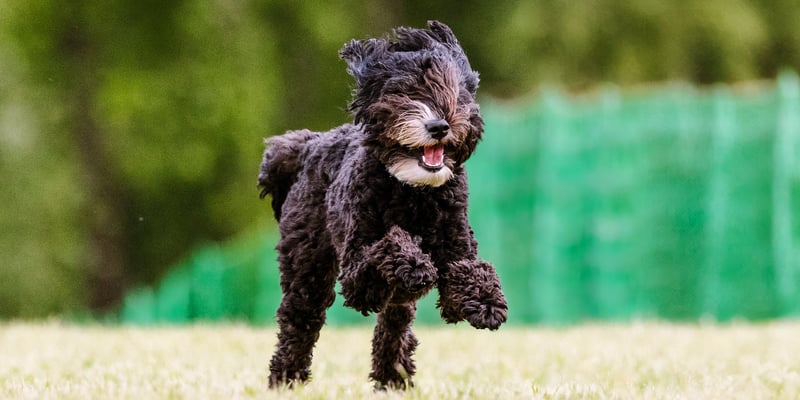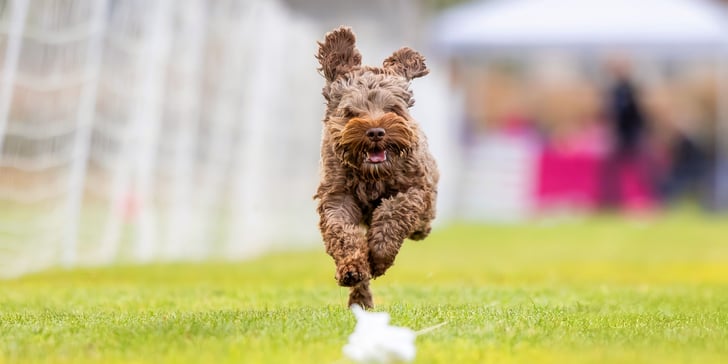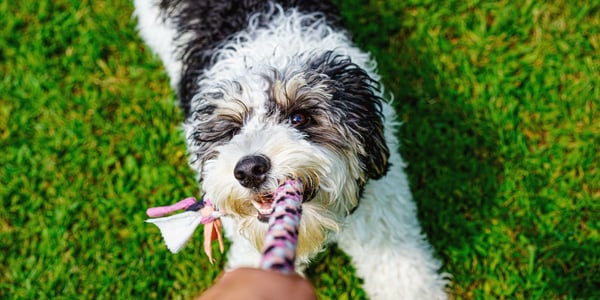Labradoodle Temperament Guide - Breed Characteristics
Index:



Introduction
The Labradoodle is famous for their bright spirit, soft coat, and big heart. If you are weighing up whether this dog breed suits your home, you are in the right place.
In this guide, we unpack their temperament, daily life, and care, so you can match the Labradoodle characteristics you love with the lifestyle you have.
If you are brand new to the mix, start with 'What exactly is a Labradoodle?' It explains the Labrador and Poodle mixes' story, which is the root of their temperament and personality.
Key takeaways
Most Labradoodles are sociable, gentle, and intelligent dogs that are easy to train when you keep sessions short and upbeat.
Size, genetics and sometimes even the coat type influence energy, grooming, and home needs.
Strong bonding can lead to separation anxiety, so plan training early.
Health, diet, and grooming all affect mood and behaviour.
Insure wisely and know how long your Labradoodle may live.
For deeper context on history, care, and buying tips, keep our Labradoodle Breed Guide close.



What shapes the Labradoodle’s temperament?
Parent breeds and genetics
The Labradoodle dog is a designer Doodle created from a cross between a Labrador and a Poodle.
Many traits are predictable because Labradoodles are a cross with clear parent influences.
Your dog may feel very much like a Labrador in sociability, while others show sharper Poodle-style focus and sensitivity.
Expect loyalty and people-pleasing, often inherited from their Labrador parents.
Expect quick learning and a need for mental work, often thanks to their Poodle lineage: thanks to their Poodle lineage.
If your dog has an active Labrador Retriever parent line, you may see a strong retrieving drive and a love of water.
A historical note
Labradoodles were first developed for allergy-friendly assistance dogs in Australia.
Wally Conron at the Royal Guide Dogs Association and the Guide Dogs Association of Australia explored this mix to create an allergy-aware guide dog pool.
That origin explains why the Labradoodle personality often blends kindness, clarity, and resilience.
For the full picture on history, sizes, and care, visit the Labradoodle Breed Guide.
Early socialisation and training
Good social habits are built, not luck. Start early. Follow this guide to ensure people and other dogs experience interactions which are positive.
Here is your link to help with a more confident start: Guide to socialising your puppy.
Keep sessions short and happy. The mix is easy to train, but also easy to bore if you repeat drills.
Use play, food, and praise to successfully train a Labradoodle.
Plan a routine for your Labradoodle training which covers calm greetings, loose-lead walking, and a solid settling down time.
Rotate locations and helpers. Training Labradoodles in different places builds confidence.
Puppies need gentle steps and lots of sleep.
Labradoodle puppies will thank you for a predictable routine and kind boundaries.
Size and coat type influence
There is more than one type of Labradoodle. They vary in size, coat style, and feel.
Small to medium dogs are referred to as Mini Labradoodles. Larger lines, however, suit active homes as they require more exercise.
Learn all about the Labradoodle's size here in our complete guide.
Coats differ. Curly, wavy, or straighter. Each coat type has different grooming demands.
Many expect no shedding. The truth is mixed. Some Labradoodles shed, some barely do. Get clarity about their coat and allergies here: understanding coat and allergy traits.



Is a Labradoodle the right fit as your family dog?
These friendly dogs make family life brighter when matched well.
The Labradoodle dog breed is often a top family dog choice because it blends warmth with brains.
High social drive. They love joining in on sofa time and school runs.
Often an intelligent dog that picks up rules quickly.
Many work as a therapy dog or in roles as assistance dogs and guide dog helpers, thanks to their steady nature when well-bred and well-trained.
They can be energetic dogs. Plan daily exercise accordingly.
Adoption, breeders, and standards
Thinking of adopting a Labradoodle or planning to get a Labradoodle from a breeder? Then be sure to vet your sources.
Ask about parent dogs and health tests.
Confirm breeder transparency, contracts, and aftercare. Choose a reputable
Labradoodle source.
Remember, there is a specific breed standard for all lines but you can expect size variations.
Quick size and lifestyle guide
Use this table to match your home to likely needs. Every dog is an individual, yet patterns help.
Tip: There is no single best dog for everyone. Be honest about your time, energy, and budget.



Daily care and training tips
Exercise and mind work
A smart dog without a job invents one. Meet the bored Labradoodle that redecorates using the kitchen bin. So it's best to keep minds busy.
Two brisk walks daily, tailored to age and health.
Sniffing games, hide-and-seek, and short training bursts.
Food puzzles and chews for calm times.
Retrieving, scent work, and trick training. Many tasks suit the traits Labradoodles often inherit from both sides.
Grooming and coat care
Coats differ by line and generation. Some need more salon time for luxurious locks.
However, in general:
Brush 3 to 4 times a week to prevent mats.
Professional trim every 6 to 8 weeks.
Ears and nails monthly.
It's good to learn to groom a Labradoodle safely, even if you book pros often.
Diet and health
Mood follows the body. A steady Labradoodle diet supports good behaviour.
Choose complete, balanced food with your vet’s guidance.
Keep treats under 10 per cent of daily calories.
Watch weight. Extra kilos strain joints and sap fizz.
Plan for optimal Labradoodle health across their life. For more info about how long your Labradoodle may live, you can read more here. Learn which issues are more common, then plan appropriate checks.
These include hips, elbows, eyes, and some skin and ear problems. Understanding common Labradoodle health issues helps you act early. Responsible owners also plan proper cover. You can protect your Labradoodle with tailored insurance so money worries do not delay care when you need it.



Life stages and generations
Puppies and adults behave differently. Different lines and generations add more variety.
First generation Labradoodle is often written F1. One Labrador plus one Poodle.
F1b Labradoodle means one parent is an F1 and the other is a Poodle or Labrador. Coat predictability may rise, yet temperament still varies.
Other notations exist. Ask breeders to explain the type they offer.
Here is what you might see across ages.
Labradoodle puppies. Playful, mouthy, curious. They nap a lot. Short training wins big.
Adult Labradoodle. Settles into routine. Energy is high but more focused. Keep learning alive with interactive sessions.
Older dogs. Slower, sweeter, and sometimes more anxious. Gentle exercise, joint care, and mental games keep joy alive.
Remember that Labradoodle parents and the wider lines shape outcomes. The mix of Labrador and Poodle gives you a bright, social worker at heart. Many owners say their dog is both a cuddle bug and a clown. Our job is to guide that spark with thoughtful Labradoodle care.



Behaviour watch-outs and support
Separation and bonding
Many Labradoodles love being close. That is a gift, but too much reliance can lead to worry when you leave. If your dog pants, whines, or chews when alone, help is here. Read this guide to prevent and treat separation anxiety.
Starter plan for separation training.
Build alone-time confidence in tiny steps.
Leave a safe chew and a food puzzle.
Keep departures and returns calm, low voice.
Use a camera and notes to track progress.
If problems persist, speak with your vet and a qualified behaviourist.
Social skills and impulse control
We want a dog that enjoys people and other dogs. Keep greetings calm. Reward four paws on the floor when not jumping up.
Teach a hand target, a ‘sit’, and a ‘settle’ with short commands and always keep sessions fun. This breed responds best to kindness, clarity, and consistency.
Final pointers
Always meet Labradoodle parents if buying. See temperament, not just looks.
Ask for hip, elbow, and eye test results. Responsible Labradoodle breeders will share them.
There is natural variety within the single breed standard. That is part of the charm.
Budget for care. Insurance lets you protect your Labradoodle with tailored insurance so you can prioritise welfare.
If you are starting from scratch, begin with our blog post 'What exactly is a Labradoodle?' Then add the Labradoodle Breed Guide to your favourites. Those two links plus this temperament guide will set you up to choose well, welcome well, and enjoy every silly wiggle.
Waggel Pet Insurance
Need more help? You're in luck if you're a Waggel Pet Insurance member. Along with our excellent coverage, we offer access to a 24/7 online vet to answer all your sticky questions, especially if you need grooming assistance.
Not a member? Why not get a quote now and cover your furry friend for a range of illnesses, all while enjoying our amazing perks and rewards.
Want more like this?
Get updates from us with helpful info, advice, answers to frequently asked questions and much more.
Index:
Related posts:
Get your quote
Along with our excellent coverage, we offer access to a 24/7 online vet to answer all your sticky questions.





